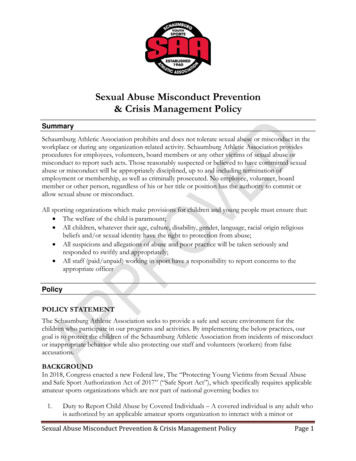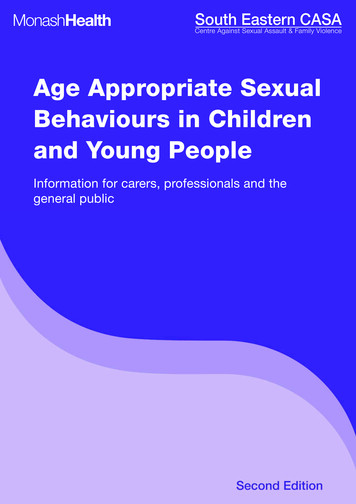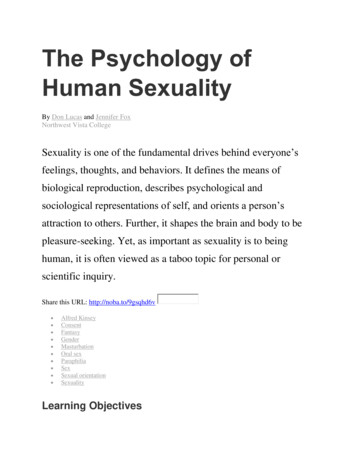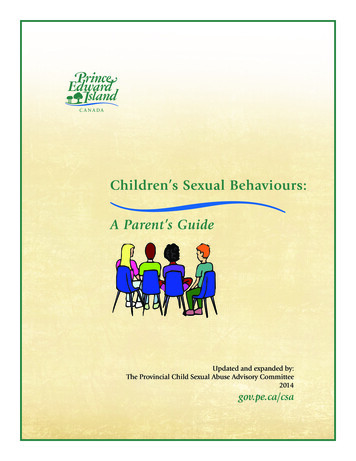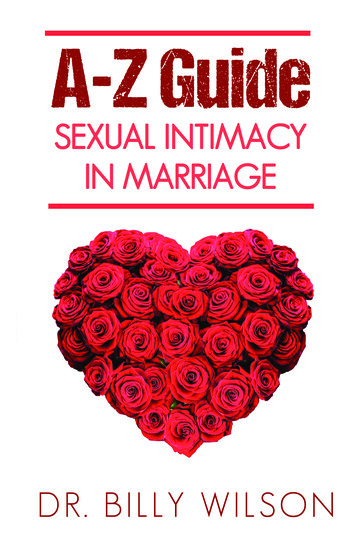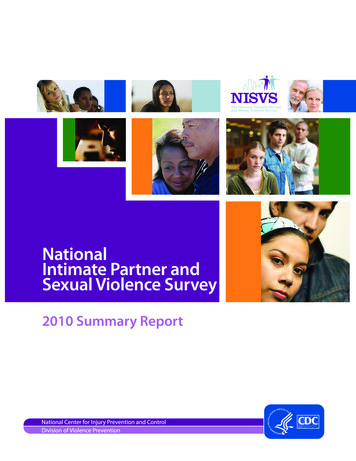
Transcription
May 26, 2020www.citizen.org15-Year Summary of Sexual Misconduct by U.S. Physicians Reportedto the National Practitioner Data Bank, 2003 ― 2017In-Depth, Updated Evidence on White Coat Betrayal
PUBLIC CITIZENPHYSICIAN SEXUAL MISCONDUCT IN THE NPDBAcknowledgmentsThis report was written by Azza AbuDagga, Ph.D., Health Services Researcher of Public Citizen’sHealth Research Group (HRG); Michael Carome, M.D., Director of the HRG; Sidney Wolfe,M.D., Founder and Senior Advisor of the HRG; and Robert Oshel, Ph.D., Consultant for HRG andretired Associate Director for Research and Disputes, National Practitioner Data Bank.We are indebted to the research staff at the Division of Practitioner Data Bank, Health Resourcesand Services Administration, for granting us access, without any identifying information aboutindividuals or organizational entities, to the restricted data that we analyzed in this study. We thankFiona Lynn, M.P.S., Managing Editor for the HRG, for copyediting this report. We also thankDiane Krauthamer, M.A., HRG Web Coordinator, for her assistance with preparing one of thefigures.About Public CitizenPublic Citizen is a national nonprofit organization with more than 500,000 members andsupporters. We represent consumer interests through lobbying, litigation, administrative advocacy,research and public education on a broad range of issues including safe and affordable health care,consumer rights in the marketplace, product safety, financial regulation, campaign finance reformand government ethics, fair trade, climate change, and corporate and government accountability.Public Citizen’s Health Research Group1600 20th Street N.W.Washington, D.C. 20009P: 202-588-1000http://www.citizen.org 2020 Public Citizen. All rights reserved
PUBLIC CITIZENPHYSICIAN SEXUAL MISCONDUCT IN THE NPDBExecutive Summary“I will come for the benefit of the sick, remaining free of . . . sexual relations with bothfemale and male persons.” — The Hippocratic oath, fourth century B.C.1BackgroundSexual relations between physicians and their patients are unequivocally unethical andcause lasting harm for these patient victims. Yet, some physicians cross this bright line: hardly aweek goes by without a shocking media story exposing new cases of physicians who sexuallyabused multiple patients, often over the course of years or even decades.Due to several factors ― including underreporting by victims and bystander health careprofessionals and the largely secretive, self-regulated nature of the medical profession ― verylittle is known about the full extent and context of this problem in the U.S.PurposesPublic Citizen’s Health Research Group sought to examine quantitative and qualitativedata for physicians who have been reported to the National Practitioner Data Bank (NPDB) ― anational repository for reports containing information on medical malpractice payments(malpractice payments) and certain adverse actions related to physicians and other health carepractitioners ― due to sexual misconduct. This analysis updates the results of our 2016 study2 onthis issue and benefits from illuminating nonpublic information that provides a morecomprehensive account about the characteristics of physicians with NPDB reports involvingsexual misconduct, the forms and details of the sexual misconduct that they inflicted on theirvictims, the characteristics of these victims, and various other contextual factors that may explainthe persistence of this problem in the U.S.MethodologyWe analyzed retrospective data from the NPDB from January 1, 2003, to December 31, 2017,for three types of physician reports in which sexual misconduct was specified as the basis (reason)for disciplinary action or malpractice payment: (1) reports of licensing actions taken by statemedical boards (hereafter referred to as “licensing reports”); (2) reports of clinical-privilegesactions taken by peer-review committees at hospitals, other health care organizations, or healthplans (hereafter referred to as “clinical-privileges reports”); and (3) reports of malpracticepayments by malpractice insurers or institutional payers (hereafter referred to as “malpracticepayment reports”). The analysis used a report-level data file that contained the deidentified datafor all variables included in the NPDB Public Use Data File and for a number of nonpublic NPDBreport-level restricted variables (including physician specialty and gender, month and year1Edelstein L. The Hippocratic Oath: Text, translation and interpretation. In: Veatch R, ed. Cross culturalperspectives in medical ethics: Readings. Boston: Jones and Bartlett; 1989:6-24.2AbuDagga A, Wolfe SM, Carome M, Oshel RE. Cross-sectional analysis of the 1039 U.S. physicians reported to theNational Practitioner Data Bank for sexual misconduct, 2003–2013. PLoS One. 2016;11(2):e0147800.MAY 26, 2020i
PUBLIC CITIZENPHYSICIAN SEXUAL MISCONDUCT IN THE NPDBversions of all report date variables, and narrative descriptions) for those physicians with sexualmisconduct–related reports in our study.Main ResultsA total of 1,354 unique physicians had sexual-misconduct–related reports during our studyperiod. Ninety-three percent of these physicians had only one type of these reports: 76.6% hadonly licensing reports, 8.4% had only clinical-privileges reports, and 7.7% had only malpracticepayment reports. The remaining 7.3% physicians had more than one type of these reports.These 1,354 physicians accounted for 0.2% of the U.S. general physician population and1.1% of all physicians with NPDB reports that met our study criteria. These proportions are muchlower than the proportion of physicians who self-reported sexual contact with patients inanonymous surveys.Ninety percent of the physicians with sexual-misconduct–related reports identified in ourstudy were aged 40 years or older. There were significantly more physicians aged 50 years or olderand fewer physicians younger than 40 years with sexual-misconduct–related reports than theirrespective representations in the U.S. general physician population. Ninety-four percent of thephysicians with these reports were men, although male physicians accounted for only 66.9% ofthe U.S. general physician population (P .0001). Three specialties (family medicine/generalpractice, psychiatry, and obstetrics and gynecology) collectively accounted for 51.1% of thephysicians with sexual-misconduct–related reports and each was significantly over-representedamong physicians with these reports relative to their representation in the U.S general physicianpopulation.The mix of victim types (patients or non-patients) reported in the narrative descriptionsvaried across the three types of physician sexual-misconduct–related reports. Sixty-two percent ofthe 1,133 physicians with licensing reports for these offenses had only patient victims identified(32.5% had only unspecified victim types). Forty-seven percent of the 163 physicians with clinicalprivileges reports for these offenses had only patient victims identified, and 27.0% had onlynonpatient-employee victims identified (19.6% had only unspecified victim types). Most (93.2%)of the 161 physicians with malpractice-payment reports for these offenses had only patient victimsidentified. Although information about victim vulnerability was not consistently reported, 16.9%,14.1%, and 50.3% of the physicians with sexual-misconduct–related licensing, clinical-privileges,and malpractice-payment reports, respectively, had patient victims who had certain vulnerabilityfactors, such as mental illness or being a minor.We found that 18.5% and 36.8% of the physicians with sexual-misconduct–relatedlicensing and clinical-privileges reports, respectively, had multiple victims. Additionally, 3.0%and 19.6% of the physicians with sexual-misconduct–related licensing and clinical-privilegesreports, respectively, had a history or pattern sexual misconduct. We also found that 17.4% of thephysicians with sexual-misconduct–related malpractice-payment reports had multiple victims (asevidenced mostly by having multiple reports involving different victims).Physical sexual contact or relations was the primary form of sexual misconduct for 41.0%of the physicians with licensing reports, 47.2% of those with clinical-privileges reports, and 60.9%of those with malpractice-payment reports that involved sexual-misconduct–related offenses.Additionally, nonspecific sexual misconduct (including “boundary violation,” “sexual act,”“sexual harassment,” and “trading drugs/prescriptions/treatment for sexual favor”) was theMAY 26, 2020ii
PUBLIC CITIZENPHYSICIAN SEXUAL MISCONDUCT IN THE NPDBprimary form of sexual misconduct for 31.2% of the physicians with licensing reports, 39.9% ofthose with clinical-privileges reports, and 32.9% of those with malpractice payment reports thatinvolved sexual-misconduct–related offenses. Inappropriate comments or communication was theprimary form of sexual misconduct for 1.2%, 4.3%, and 0.6% of the physicians with licensing,clinical-privileges, and malpractice-payments reports that involved sexual-misconduct–relatedoffenses, respectively. Other forms of sexual misconduct, such as “indecent exposure,”“ejaculation in presence of others/masturbation in presence of others,” and “possession ofpornography,” accounted for less than 1% of the primary forms of sexual misconduct perpetratedby the physicians with each of these three report types. No details were available to determine theform of sexual misconduct for the remaining 26.0%, 8.0%, and 5.6% of physicians with licensing,clinical-privileges, and malpractice-payments reports that involved sexual-misconduct–relatedoffenses, respectively.Fifty-two percent and 41.1% of the physician sexual-misconduct–related licensing andclinical-privileges reports, respectively, included at least one other basis for actions in addition tosexual misconduct. These additional bases included criminal convictions, violations of laws,unprofessional conduct, negligence or substandard care, patient abuse, and being an immediatethreat to health or safety. For the physician sexual-misconduct–related malpractice-paymentreports, 21.4% had additional malpractice allegations other than sexual misconduct listed in thereports, including improper management and assault and battery.Our analysis of physician sexual-misconduct–related licensing and clinical-privilegesreports showed that when medical boards and peer-review committees at hospitals, health careorganizations, or health plans took disciplinary actions against physicians for sexual misconduct,their actions tended to be more serious than those taken against physicians with other offenses.However, 510 (37.7%) of the physicians with sexual-misconduct–related NPDB reports continuedto have active licenses and clinical privileges in the states where they were disciplined, or hadmalpractice payments due to their sexual-misconduct offenses. Because some physicians may havehad active licenses and clinical privileges in states other than the ones in which they weredisciplined, an even higher proportion of physicians may have been able to continue practicingmedicine because medical boards and health care organizations in these other states may not havetaken disciplinary actions against these physicians that resulted in revocation or suspension of theirlicenses and clinical privileges.Of the 317 physicians with at least one sexual-misconduct–related clinical-privileges ormalpractice-payment report, 221 (69.7%) had not been disciplined by any state medical board forsuch misconduct during our study period. Importantly, 151 (68.3%) of these 221 physicianscommitted sexual misconduct involving patient victims and 61 (27.6%) committed sexualmisconduct involving multiple victims. Physical sexual contact or relations and nonspecific sexualmisconduct were the primary reported forms of sexual misconduct perpetrated by 116 (52.5%) and85 (38.5%) of these 221 physicians, respectively.MAY 26, 2020iii
PUBLIC CITIZENPHYSICIAN SEXUAL MISCONDUCT IN THE NPDBOur report presents powerful case examples that illustrate several ways in which largelyself-regulated state medical boards and medical peer-review committees in health careorganizations deal leniently with sexually abusive physicians, failing to prioritize patients’protection over the interest of these physicians. Examples include the following:(1) Sexual abuse is regarded as a knowledge gap (that can be bridged by boundary orethics classes) or an illness that can be cured by psychiatric evaluation and“rehabilitation;”(2) Private nonreportable agreements, consent decrees, or suspended disciplinary actionsoften are employed as the first line of action against these physicians;(3) A chaperone requirement or limitation/restriction of clinical practice or license areoften the second line of action against these physicians until they are “rehabbed” andreturned to practice;(4) Sexually abusive physicians can be permitted to resign, surrender their licenses orclinical privileges, or retire to avoid revocation actions ― allowing them to move toother health care organizations or obtain licenses in other states; and(5) Reporting entities may conceal sexual misconduct in the NPDB by using nonspecificBasis for Action Codes, such as “unprofessional conduct,” in lieu of the “sexualmisconduct” code.We also discuss other factors that we identified from the literature that perpetuate theproblem of sexual abuse by physicians.ConclusionsThe number of physicians who have been reported to the NPDB due to sexual misconductremains low. Therefore, our report only scratches the surface of the full extent of physician sexualmisconduct in the U.S. Unfortunately, this problem has not received the attention it deserves fromthe medical community. It is incumbent on the medical community to adopt an explicit zerotolerance standard against sexual abuse of patients or others by physicians in all its forms. Suchphysicians must not be allowed to practice medicine. We also call on the medical community tomake tangible systemic and cultural changes to attain this goal. We provide more than a dozenactionable recommendations to begin the quest for that zero-tolerance standard.MAY 26, 2020iv
PUBLIC CITIZENPHYSICIAN SEXUAL MISCONDUCT IN THE NPDBTable of ContentsExecutive Summaryi1.1Introduction1.1 Background .11.2 Study Rationale .21.3 Definitions: Sexual Misconduct/Abuse .21.4 Ethical Problems With Physician Sexual Abuse .41.5 Harmful Effects of Physician Abuse on Patients .51.6 Study Purposes.62.Methodology82.1 Data Sources .82.2 Selection Criteria .92.2.1 Physician Report Types .92.2.2 Classifications of Physician Reports as Sexual-Misconduct–RelatedVersus Other (Nonsexual-Misconduct–Related) .92.2.3 Excluded Reports .102.2.4 Study Period .102.2.5 Narrative Descriptions .102.3 Data Elements .112.3.1 Physician Characteristics .112.3.2 Number and Characteristics of Victims of Physician Sexual Misconduct .112.3.3 Malpractice Victim Variables and Setting in Sexual-Misconduct–Related Versus Other-Offenses–Related Reports .122.3.4 Primary Forms of Sexual Misconduct .122.3.5 Licensing Actions .132.3.6 Clinical-Privileges Actions .132.3.7 Size of Sexual-Misconduct–Related Malpractice Payments .142.3.8 Other Bases for Action/Malpractice Allegations in Sexual-Misconduct–Related Reports .152.3.9 Contextual Sexual-Misconduct–Related Information.152.4 Analytic Approach .152.4.1 Units of Analysis.152.4.2 Content Analysis .152.4.3 Statistical Analysis .163.Results3.117Categorization and Characteristics of All Physicians With SexualMisconduct–Related Reports .173.1.1 Demographic Characteristics of Physicians With Sexual-Misconduct–Related Reports .18MAY 26, 2020v
PUBLIC CITIZENPHYSICIAN SEXUAL MISCONDUCT IN THE NPDB3.1.2 Types and Specialties of Physicians With Sexual-Misconduct–RelatedReports .193.1.3 Examples of Physician Sexual Misconduct .213.2 Physicians With Sexual-Misconduct–Related Licensing Reports .233.2.1 Triggers of Licensing Actions Due to Physician Sexual Misconduct .233.2.2 Victims of Physicians With Sexual-Misconduct–Related LicensingReports .233.2.3 Primary Forms of Sexual Misconduct Committed by Physicians WithSexual-Misconduct–Related Licensing Reports .253.2.4. History or Pattern of Sexual Misconduct Among Physicians WithSexual-Misconduct–Related Licensing Reports .263.2.5 Additional Bases for Action in Physician Sexual-Misconduct–RelatedLicensing Reports .283.2.6 Types of Actions Taken by State Medical Boards Against PhysiciansWith Sexual-Misconduct–Related Licensing Reports .293.2.7 Actions Taken by State Medical Boards for Sexual-Misconduct–RelatedVersus Other-Offenses–Related Licensing Reports .333.3 Physicians With Sexual-Misconduct–Related Clinical-Privileges Reports .343.3.1 Triggers of Clinical-Privileges Actions Due to Physician SexualMisconduct .343.3.2 Victims of Physicians With Sexual-Misconduct–Related ClinicalPrivileges Reports .353.3.3 Primary Forms of Sexual Misconduct Committed by Physicians WithSexual-Misconduct–Related Clinical-Privileges Reports .363.3.4 History or Pattern of Sexual Misconduct Among Physicians WithSexual-Misconduct–Related Clinical-Privileges Reports .373.3.5 Additional Bases for Action in Physician Sexual-Misconduct–RelatedClinical-Privileges Reports .393.3.6 Types of Actions Taken by Peer-Review Committees at Hospitals, OtherHealth Care Organizations, or Health Plans Against Physicians With SexualMisconduct–Related Clinical-Privileges Reports .403.3.7 Clinical-Privileges Actions Taken by Hospitals, Other Health CareOrganizations or Health Plans for Sexual-Misconduct–Related Versus OtherOffenses–Related Reports .433.4 Physicians With Sexual-Misconduct–Related Malpractice-Payment Reports .443.4.1 Victims of Physicians With Sexual-Misconduct–Related MalpracticePayment Reports .443.4.2 Primary Forms of Sexual Misconduct Committed by Physicians WithSexual-Misconduct–Related Malpractice-Payment Reports .453.4.3 Additional Malpractice Allegations in Physician Sexual-Misconduct–Related Malpractice-Payment Reports .463.4.4 Sexual-Misconduct–Related Malpractice Payment Amounts .473.4.5 Victim Characteristics in Physician Sexual-Misconduct–Related VersusOther-Allegations–Related Malpractice-Payment Reports.483.4.6 Severity of Victim Injury in Physician Sexual-Misconduct–RelatedVersus Other-Allegation–Related Malpractice-Payment Reports .49MAY 26, 2020vi
PUBLIC CITIZENPHYSICIAN SEXUAL MISCONDUCT IN THE NPDB3.5Overall Impact of Sexual-Misconduct–Related Reports on Licenses andClinical Privileges of Offending Physicians .503.6 Evidence of Unwarranted State Medical Board and Health Care OrganizationLeniency With Physicians Who Engaged in Sexual Misconduct .513.6.1 Physicians With No Licensing Reports for Sexual Misconduct DespiteEvidence of These Offenses From Clinical-Privileges or Malpractice-PaymentReports .513.6.2 Examples of State Medical Board Leniency With Physicians WhoEngaged in Sexual Misconduct and Had Sexual-Misconduct–RelatedLicensing Reports .543.6.3 Examples of Health Care Organization Leniency With Physicians WhoEngaged in Sexual Misconduct and Had Sexual-Misconduct–Related ClinicalPrivileges Reports .614.Discussion644.1 Extent of Physician Sexual Misconduct Reported to the NPDB Relative to PriorStudies .644.2 Triggers of Actions Taken Against Physicians With Sexual-Misconduct–Related Licensing and Clinical-Privileges Reports .654.3 Characteristics of Physicians With Sexual-Misconduct–Related Reports .664.4 Characteristics of Victims of Physician Sexual Misconduct .674.5 Primary Forms of Sexual Misconduct Committed by Physicians .684.6 Past as Prelude: Multiple Victims, Recidivism, and Other Offenses .694.7 Insufficient Licensing and Clinical-Privileges Actions .704.8 Factors That Keep Physician Sexual Misconduct in the Dark.714.8.1 Underreporting by Victims .714.8.2 Underreporting by Colleagues .724.8.3 Inadequate Guidelines for Addressing Physician Sexual Misconduct .734.8.4 State Medical Board Shortcomings .734.8.5 Health Care Organization Shortcomings .784.9 Study Limitations and Need for Future Research .794.10 Actionable Recommendations to Get to a Zero-Tolerance Standard AgainstPhysician Sexual Misconduct .814.11 Conclusions.84MAY 26, 2020vii
PUBLIC CITIZENPHYSICIAN SEXUAL MISCONDUCT IN THE NPDBList of TablesTable 1. Categories of Physicians With Sexual-Misconduct–Related NPDB Reports byReport Type, 2003–2017 (Physician-Level Results) .18Table 2. Characteristics of Physicians With Sexual-Misconduct–Related Reports VersusThose of the U.S. General Physician Population (Physician-Level Results) .19Table 3. Specialty Distribution of Physicians With Sexual-Misconduct–Related ReportsVersus Those in the U.S. General Physician Population (Physician-LevelResults) .20Table 4. Additional Bases for Action in Physician Sexual-Misconduct‒Related LicensingReports (n 1,289) .29Table 5. Actions Taken by State Medical Boards Against Physicians With SexualMisconduct–Related Licensing Reports, by Primary Forms of SexualMisconduct (Physician-Level Results) .31Table 6. Actions Taken by State Medical Boards for Sexual-Misconduct–Related VersusOther-Offenses–Related Physician Licensing Reports (Report-Level Results) .33Table 7. Additional Bases for Action in Physician Sexual-Misconduct‒Related ClinicalPrivileges Reports (n 180) .39Table 8. Actions Taken by Peer-Review Committees at Hospitals, Other Health CareOrganizations, or Health Plans Against Physicians With Sexual-Misconduct–Related Clinical-Privileges Reports, by Primary Forms of Sexual Misconduct(Physician-Level Results) .41Table 9. Actions Taken by Peer-Review Committees at Hospitals, Other Health CareOrganizations, or Health Plans for Sexual-Misconduct–Related VersusOther-Offenses–Related Physician Reports (Report-Level Results) .43Table 10. Additional Malpractice Allegations in Physician Sexual-Misconduct‒RelatedMalpractice-Payment Reports (n 206).47Table 11. Malpractice Payment Amounts for Physicians With Sexual-Misconduct–Related Malpractice-Payment Reports, by Primary Forms of SexualMisconduct (Physician-Level Results) .48Table 12. Victim Characteristics and Type of Victim Injury in Physician SexualMisconduct–Related Versus Other-Allegations–Related MalpracticePayment Reports (Report-Level Results) .49MAY 26, 2020viii
PUBLIC CITIZENPHYSICIAN SEXUAL MISCONDUCT IN THE NPDBList of FiguresFigure 1: Categorization of the 1,354 Physicians With Sexual-Misconduct–RelatedReports by Report Type .17Figure 2. Identified Victim Types for the 1,133 Physicians With Sexual-Misconduct‒Related Licensing Reports .24Figure 3. Primary Forms of Sexual Misconduct Committed by the 1,133 Physicians WithSexual-Misconduct‒Related Licensing Reports .25Figure 4. Effect of Sexual-Misconduct–Related Licensing Actions on Physicians’ Abilityto Practice in Their Respective States (n 1,133).30Figure 5. Identified Victim Types for the 163 Physicians With Sexual-Misconduct‒Related Clinical-Privileges Reports .36Figure 6. Primary Forms of Sexual Misconduct Committed by the 163 Physicians WithSexual-Misconduct‒Related Clinical-Privileges Reports.37Figure 7. Effect of Sexual-Misconduct–Related Clinical-Privileges Actions onPhysicians’ Ability to Practice at Their Respective Hospitals or Health CareOrganizations .42Figure 8. Identified Victim Types for the 161 Physicians Wi
In-Depth, Updated Evidence on White Coat Betrayal May 26, 2020 . campaign finance reform and government ethics, fair trade, climate change, and corporate and government accountability.


